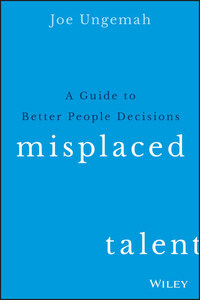Cover design: Michael J. Freeland
This book is printed on acid-free paper.
Copyright © 2015 by Joe Ungemah. All rights reserved
Published by John Wiley & Sons, Inc., Hoboken, New Jersey
Published simultaneously in Canada
No part of this publication may be reproduced, stored in a retrieval system, or transmitted in any form or by any means, electronic, mechanical, photocopying, recording, scanning, or otherwise, except as permitted under Section 107 or 108 of the 1976 United States Copyright Act, without either the prior written permission of the Publisher, or authorization through payment of the appropriate per-copy fee to the Copyright Clearance Center, 222 Rosewood Drive, Danvers, MA 01923, (978) 750-8400, fax (978) 646-8600, or on the web at www.copyright.com. Requests to the Publisher for permission should be addressed to the Permissions Department, John Wiley & Sons, Inc., 111 River Street, Hoboken, NJ 07030, (201) 748-6011, fax (201) 748-6008, or online at www.wiley.com/go/permissions.
Limit of Liability/Disclaimer of Warranty: While the publisher and author have used their best efforts in preparing this book, they make no representations or warranties with the respect to the accuracy or completeness of the contents of this book and specifically disclaim any implied warranties of merchantability or fitness for a particular purpose. No warranty may be created or extended by sales representatives or written sales materials. The advice and strategies contained herein may not be suitable for your situation. You should consult with a professional where appropriate. Neither the publisher nor the author shall be liable for damages arising herefrom.
For general information about our other products and services, please contact our Customer Care Department within the United States at (800) 762-2974, outside the United States at (317) 572-3993 or fax (317) 572-4002.
Wiley publishes in a variety of print and electronic formats and by print-on-demand. Some material included with standard print versions of this book may not be included in e-books or in print-on-demand. If this book refers to media such as a CD or DVD that is not included in the version you purchased, you may download this material at http://booksupport.wiley.com. For more information about Wiley products, visit www.wiley.com.
Library of Congress Cataloging-in-Publication Data:
Ungemah, Joe.
Misplaced talent: a guide to making better people decisions / Joe Ungemah.
pages cm
Includes index.
ISBN 978-1-119-03094-2 (hardback); ISBN 978-1-119-03097-3 (pdf);
ISBN 978-1-119-03090-4 (epub)
1. Decision making. 2. Personnel management. I. Title.
HD30.23.U54 2015
658.3′128 – dc23
2015008302
When Joe asked me to write a foreword for his book, Misplaced Talent, the request arrived on the very same day that I completed an article I was working on with a colleague from another university looking at the relationship between science and practice (“the science-practice gap”). We reported on some research we had been doing on the ways in which practitioners bring scientific evidence to bear in their practice within the field of “occupational psychology,” as we Brits call it, or, for those with a more European or North American background, work or industrial-organizational psychology.
Despite differences in name, what comes through from the wealth of international experience upon which this book is based is that there are many more commonalities than differences when we look at how psychology has been applied to the world of work across the globe, but yet practitioners can sometimes struggle in their attempts to translate and apply to their own practice the very rich body of scientific research and theory upon which the profession is based. This is why Misplaced Talent is such a useful book.
Recognizing that the fundamental drivers of performance in the workplace stem directly from the most basic and deeply held set of motivations and desires that we all share in common as members of the human race, Joe’s ability to see beyond the surface details, through to the very heart of what drives human beings in a work context, and then to use the insights thus gained to see the bigger organizational picture is what characterizes both his own work as a practitioner and this book.
I recall a time over a decade ago when I invited Joe to make a presentation at the university research centre I was running at the time. Duly armed with enough data to satisfy the hardest-nosed of empiricists, along with a PowerPoint presentation of accompanying statistical analyses that would leave even the most eager of statisticians similarly sated, he scrolled effortlessly through his slides, pointing out the key findings to the varied audience of economists, sociologists, psychologists, and other assorted disciplinary specialists that are to be found in most university-based business schools.
After the presentation, the usual round of questions and answers began, whereupon, of course, I expected the conventional criticisms to emerge – the sociologists taking one point of view, the economists another, and so forth. Instead, I was surprised that, although each group had a range of challenging and probing questions, they all seemed to agree on the main points that he had managed to distill from the data.








